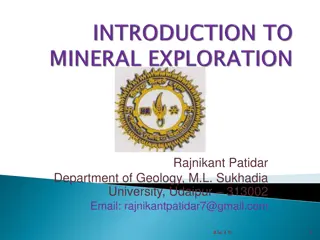Understanding Economic Geology: A Comprehensive Overview
Economic geology, as discussed in the provided content, delves into the commercial and industrial utilization of Earth's resources. Covering topics such as mineral deposits, ores, gangue minerals, common economic minerals, and classification of mineral deposits, this field plays a crucial role in identifying and extracting valuable materials for human welfare. The content further explores the types of ores, metallic and non-metallic minerals, and their various applications in industries like chemical, construction, and agriculture. Additionally, it discusses the classification of mineral deposits based on their mode of origin, distinguishing between primary and secondary deposits. The magmatic concentration process is also outlined, detailing how magmatic ore deposits form and their association with intrusive igneous rocks.
Download Presentation

Please find below an Image/Link to download the presentation.
The content on the website is provided AS IS for your information and personal use only. It may not be sold, licensed, or shared on other websites without obtaining consent from the author. Download presentation by click this link. If you encounter any issues during the download, it is possible that the publisher has removed the file from their server.
E N D
Presentation Transcript
ECONOMIC GEOLOGY PREPARED BY SK JOHNSAHEB LECTURER DEPARTMENT OF GEOLOGY HINDU COLLEGE GUNTUR
Economic geology is a broad field involves commercial and industrial uses of the resources of the earth. Resource: Anything that benefits man and that leads to human welfare is a resource. Ex: water,Mineral,solar energy. Mineral deposit: These are weather metallic and non-metallic where accumulation and concentration of one and more useful substances which are distributed in the earth s crust. Ore: A mineral from which one or more metals can be extracted profitably. Ex:magnetite is the ore of iron,Bauxite is the ore of Al.
Types of ores: 1).Simple ore: Ore that yields a single metal is called simple ore. Ex:Hematite,magnetite. 2).complex ore: Ore that yields several metals .Ex:Chalcopyrite. Gangue Mineral: A metallic, or non-metallic mineral which is associated with ore mineral is called gangue mineral. Ex: Dolomite is the Gangue mineral associated with galena. Bonanza:Bunch of ore particularly with reference to gold. Tenor :The metal content of ore is called tenor.
COMMON ECONOMIC MINERALS 1).Metallic Minerals: Ex:Hematite,galena,psilomalene,chalcopyrite. 2).Non Metallic Minerals:They are also called industrial minerals. Abrassives:Diamond,corundum,garnet,quartz,feldspar etc. Minerals used in ceramic: kaolin,feldspar,Talc,Gypsum,fluorite. Minerals used in glass: Quartz. Minerals used in Refractories: Kaolin,Andalusite,Kyanite,Sillimanite,Topaz. Minerals used in Paint and Pigments: Kaolin,Hematite,Baryte,Graphite. Minerals used in Fertilizers: Limestone,Dolomite,Gypsum,Apatite. Minerals used in paper and Rubber: Kaolin,Baryte,Gypsum,Mica,Talc,Bauxite.
Minerals used in chemical industry: Flourite,pyrite,Gypsum,Anhydrite. Buildingstones:Granite,Syenite,Gabbro,Dolerite,Basalt,Marble,Sansstone,Charnakite. CLASSIFICATION OF MINERAL DEPOSITS Mineral deposit are classified according to their mode of origin in to following two types. 1).Primary(or)Hypogene deposits 2).Secondary Deposits 1).Primary deposits are formed at depth by magmatic action. 2).Secondary deposits are formed near the surface by the action of weathering .
MAGMATIC CONCENTRATION GENERAL DESCRIPTION:Magmatic ore deposits are charectarised by their close relationship with intermediate and deep seated intrusive igneous rocks. Early Magmatic: Early Magmatic: PROCESS DEPOSITS EXAMPLE Dissemination Disseminated crystallization without concentration. Diamond pipes of Kimberly in south Africa segregation Crystallization differentiation and accumulation Chromite deposits of sukinda ultra mafic complex in Orissa. Injection Crystallization, differentiation and injection Magnetite deposit Late magmatic Residual liquid segregation Crystallization, differentiation, residual magma accumulation Titan ferrous magnetite deposits of mayurbhanj in Orissa.
Residual liquid injection Crystallization differentiation with filter pressing and injection Magnetite deposits Immiscible liquid segregation Immiscible liquid separation of accumulation Sulphide deposits Immiscible liquid injection Immiscible liquid separation with injection Nickle sulphide deposits sublimation sublimates Sulphide deposits Contact metamorphism Contact metasomatic Iron ore deposits Hydrothermal deposits Cavity filling deposits a).Fissure vein b).saddle reef c).ladder veins d).shear zones E).breccia filling f).Vesicular filling Base metal deposits of agnigundala in Guntur dist. of Ap Pegmatite Pegmatite deposits Mica deposits Sedimentation Sedimentary deposits Iron ,Mn
Sub marine volcanism Sub marine deposits Iron,mn,phasphatic nodules Evaporation Evaporates a).Marine b).lake Gypsum, nitrates Residual concentration Residual deposits Bauxite,mn,Fe Mechanical concentration Placer deposits: 1).Beach 2).Alluvial 3).Aeolian 4).colluvial Gold,zircon,monazites Metamorphism Metamorphosed deposits Graphite,Talc,Asbestos,Kyanite,Silli manite,garnet.
TYPES OF ORE DEPOSITS TYPES OF ORE DEPOSITS Syngenetic ore deposit: The ore deposits that are formed at the same time as the enclosing rock, are called Syngenetic ore deposits. Ex:sedimentary ore deposit. Epigenetic ore deposit: The ore deposits that are formed at the same time as the enclosing rock, are called Syngenetic ore deposits. Ex:Hydrothermal ore deposit.
MAGMATIC ORE DEPOSITS MAGMATIC ORE DEPOSITS The magmatic ore deposits are the magmatic products which crystallize from magma. They have close relationship with intrusive igneous rocks. Early magmatic ore deposit: Disseminated Deposits: When a magma crystallizes under deep sated conditions,a granular igneous rock is formed. In such a rock early formed crystals of ore minerals may occur in dissemination. Here grains of ore are found scattered more or less evenly throughout the rock mass. The disseminated deposits occur in the shape of adyke, pipe . Ex: Dissemination deposit is the diamond pipe of panna, madhyapradesh. Here diamonds occur scarcely scattered in the kimberlite mass.
SEGREGATION DEPOSITS: Early magmatic segregation deposits are formed as a result of gravitative crystallization differention. In such cases the ore minerals which crystallize early get concentrated in a particular part of the igneous mass. The ore deposits thus formed are called segregation deposits The segregation deposits are generally lenticular in shape and of relatively small size. The segregation of chromite in ultrabasic rocks is an example of this type of ore deposit.
LATE MAGMATIC DEPOSITS LATE MAGMATIC DEPOSITS: The ore deposits which are formed towards the close of he magmatic period are called late magmatic deposits. The late magmatic deposits contain those ore minerals which have crystallized at rather low temperature from a residual magma. The magma which is left after crystallization of the early formed rock silicates, is called residual magma. This magma frequently contains many ore minerals. The late magmatic deposits include most of the magmatic deposit of iron and titanium ores. These deposit are almost always associated with mafic igneous rocks. The late magmatic deposits have been classified into four groups. 1. Residual liquid segregation 2. Residual liquid injection 3. Immiscible liquid segregation 4. Immiscible liquid injection
Residual liquid segregation: In a magma particularly the basic magma which is undergoing differentiation, the residual liquid may become enriched in iron and titanium. This heavy residual liquid may segregate and crystallize within the parent igneous mass. Such ore deposit commonly occur in the form of parallel bands and may form valuble ore deposits Residual liquid injection: The iron rich residual liquid accumulated as a result of differentiation of mafic magma may get injected into the surrounding country rocks. The ore deposit of magnetic and ilmenite formed in this way are called injection ore deposit. Such deposits usually occurs in the form of veins , dykes or sills Immiscible liquid segregation: when a mafic magma cools the sulphide rich immiscible liquid separate out and accumulates at the bottom of the igneous body . This separation is similar to that of oil and water. The consolidation it gives rise to the sulphide segregation deposits. These deposit occurs commonly at the bottom of the differentiation mafic intrusive as disconnected bodies Immiscible liquid injection: The sulphide rich immiscible liquid which saparates out during the differentiation of mafic magma ,may get injected into the enclosing rocks on consolidation forms the immiscible liquid injection deposit. Such deposits are usually irregular or dyke like form.
NAME:HEMATITE DIAGNOSTIC PROPERTIES COLOUR: Iron grey colour STREAK: Cherry red LUSTRE: Metallic HARDNESS:5-6 CHEMICAL COMPOSITION:Fe2O3 MODE OF OCCURRENCE: 1).Hematite occurs as sedimentary bedded deposits, Residual deposit USES: This is an important ore of iron . Iron is used in the manufacture of steel, railway bogies, Rail way constructions, Automobiles. DISTRIBUTION IN INDIA: Chiria iron ore deposit in Jharkhand. Dhonimalai ,Bababuddan hills in Karnataka, Biladilla in madhyapradesh,Goa, Veldurty in Kurnool dst of Ap.
NAME:MAGNETITE DIAGNOSTIC PROPERTIES COLOUR: Iron grey colour STREAK: black LUSTRE: Metallic HARDNESS:5-6 CHEMICAL COMPOSITION:Fe3O4 MODE OF OCCURRENCE: 1).Magnetite occurs as sedimentary bedded deposits, Residual deposit USES: This is an important ore of iron . Iron is used in the manufacture of steel, railway bogies, Rail way constructions, Automobiles. DISTRIBUTION IN INDIA: Chiria iron ore deposit in Jharkhand. Kudremukh in Karnataka, Sitampundi insalem dst of Tamilnadu, Mayurbhanj dst in Orissa.
NAME:CHROMITE DIAGNOSTIC PROPERTIES COLOUR: Black colour STREAK: Brown LUSTRE: Metallic HARDNESS:5-6 CHEMICAL COMPOSITION:Fecr2o4 MODE OF OCCURRENCE: 1).Chromite occurs as magmatic segregation deposits, It occurs in ultra basic igneous rocks such as Dunite and peridotites. Chromite occurs as placer deposits formed by the process of mechanical concentration. USES: Chromite is ore of chromium,ferro alloys,refractories Iron is used in the manufacture of steel, railway bogies, Rail way constructions, Automobiles. DISTRIBUTION IN INDIA: Sukinda ultra mafic complex in orissa Byrapur,hassan district in Karnataka, salem dst of Tamilnadu, Kondapalli Krishna district of Ap.
NAME:PYROLUSITE DIAGNOSTIC PROPERTIES COLOUR: Black colour STREAK: Black LUSTRE: Metallic HARDNESS:2-3 CHEMICAL COMPOSITION:Mno2 MODE OF OCCURRENCE: 1).It occurs as bedded deposit formed by sedimentation, Oxidation and Residual deposits. USES: Pyrolusite is an important ore of manganese, used in manufacture of chemicals,paints&pigments. DISTRIBUTION IN INDIA: Chindwara and balaghat in Madhyapradesh. Koraput,kalhandi in Orissa. Duvvada, sadanandapuram,garividi garbham in vijayanagaram district of Ap. Bhandara deposit Nagpur on Maharashtra.
NAME:PSILOMALANE DIAGNOSTIC PROPERTIES COLOUR: Black colour STREAK: Black LUSTRE: Metallic HARDNESS:5-6 CHEMICAL COMPOSITION:Mn2O32H2o MODE OF OCCURRENCE: 1).It occurs as bedded deposit formed by sedimentation, Oxidation and Residual deposits. USES: psilomalane is an important ore of manganese, used in manufacture of chemicals,paints&pigments. DISTRIBUTION IN INDIA: Chindwara and balaghat in Madhyapradesh. Koraput,kalhandi in Orissa. Duvvada, sadanandapuram,garividi garbham in vijayanagaram district of Ap. Bhandara deposit Nagpur on Maharashtra.
NAME:CHALCOPYRITE DIAGNOSTIC PROPERTIES COLOUR: Golden yellow STREAK: Black LUSTRE: Metallic HARDNESS:3-4 CHEMICAL COMPOSITION:CuFes2 MODE OF OCCURRENCE: 1).It occurs as Hydrothermal deposit, Magmatic concentration and oxidation and supergene sulphide deposit. USES: This is an important ore of copper ,used in manufacture of chemicals DISTRIBUTION IN INDIA: Kheri copper deposit in Rajasthan. Sarigipalli in Orissa,Agnigundala in Guntur district of Ap.
NAME:GALENA DIAGNOSTIC PROPERTIES COLOUR: Lead grey STREAK: lead grey LUSTRE: Metallic HARDNESS:2-3 CHEMICAL COMPOSITION: pbs MODE OF OCCURRENCE: 1).It occurs as Hydrothermal deposit, Magmatic concentration and oxidation and supergene sulphide deposit. USES: This is an important ore of lead , lead is used in manufacture of electrical charge batteries DISTRIBUTION IN INDIA: Zawar lead deposit in Rajasthan. Sarigipalli in Orissa, Agnigundala,bandalamottu in Guntur district of Ap.
NAME:SPHALERITE DIAGNOSTIC PROPERTIES COLOUR: Black STREAK: Brown LUSTRE: Metallic HARDNESS:3-4 CHEMICAL COMPOSITION: Zns MODE OF OCCURRENCE: 1).It occurs as Hydrothermal deposit, Magmatic concentration and oxidation and supergene sulphide deposit. USES: This is an important ore of zinc , zinc is used in making alloys, chemicals ,galvanising . DISTRIBUTION IN INDIA: Zawar deposit in Rajasthan. Sarigipalli in Orissa, Agnigundala,bandalamottu in Guntur district of Ap.
NAME:BAUXITE DIAGNOSTIC PROPERTIES COLOUR: Yellowish brown STREAK: Yellow LUSTRE: Earthy HARDNESS:2-3 CHEMICAL COMPOSITION: Al2o32H2o MODE OF OCCURRENCE: 1).It occurs as Residual deposit. USES: This is an important ore of Al ,ud in making aeroplanes ,electrica applinces,building material,Auto mobiles industry. DISTRIBUTION IN INDIA: Katni,Jabalpur in Madhyapradesh. Galikonda Rakta konda in Visakhapatnam district if Ap Belgaum karanataka,Nilgiri hills Tamilnadu.
NAME:APATITE DIAGNOSTIC PROPERTIES COLOUR: Yellow FORm:columnar STREAK: white LUSTRE: vitreous HARDNESS:5 CHEMICAL COMPOSITION:Ca5F(po4)3 MODE OF OCCURRENCE: 1).It occurs as accessory mineral in Igneous rocks such as pegmatites,granites It occurs as sedimentary phasphatic deposit USES: Used in the manufacture of fertilizers, chemicals like phosphotic acid DISTRIBUTION IN INDIA: Khasipatnam in Visakhapatnam district of AP. Dungalpur in Rajastan. Trichunapalli District of Tamilnadu
NAME:ABESTOSS DIAGNOSTIC PROPERTIES COLOUR: Green Form: Fibrous STREAK: White LUSTRE: Silky HARDNESS:2-3 CHEMICAL COMPOSITION:Mg3si4o10(oH)8 MODE OF OCCURRENCE: 1).Asbestos occurs with serpentine which has been derived from the regional metamorphism of olivine bearing rock like Peridotite and Dunite. It is formed due to the alteration of Limestone and dolomite by basic intrusive rocks. USES: Used in thermal ,electrical insulation purpose,chemical laboratories table tops. DISTRIBUTION IN INDIA: Asbestoss belt in extended from Brahmanapalli,to Lingala near pulivendula in Kadapa district of Ap. Holenarsapur in hassan district is best known for the occurrence of Amphibole verity of Asbestoss.
NAME:BARITE DIAGNOSTIC PROPERTIES COLOUR: Brown Form: Tabular STREAK: White LUSTRE: vitreous HARDNESS:3-4 CHEMICAL COMPOSITION:Baso4 MODE OF OCCURRENCE: It occurs as Hydrothermal cavity filling and breccia filling deposit It occurs as sedimentary bedded deposit. USES: Used in the manufracture of barium carbonate,oil drilling industry,glass,paints,and papers industry. DISTRIBUTION IN INDIA: Mangampeta , vemula,velpula Kadapa district of Ap,Jaipur Rajastan.
NAME:CALCITE DIAGNOSTIC PROPERTIES COLOUR: White Form: Tabular STREAK: White LUSTRE: vitreous HARDNESS:3 CHEMICAL COMPOSITION:Caco3 MODE OF OCCURRENCE: It occurs as Hydrothermal deposit,also hot spring It occurs as non clastic sedimentary rocks and metamorphic rocks such as marble. USES: Used in the manufacture of cement ,Glass, ceramic, filter , Rubber ,chemical(Bleaching power) industry. Transparent verity of calcite Iceland spar used in the manufacture of Nicol prism DISTRIBUTION IN INDIA: Occurs in cave deposits of Borrak caves in Visakhapatnam,Belum caves in Kurnool.limestone deposits in kadaps.
NAME:CORRUNDUM DIAGNOSTIC PROPERTIES COLOUR: Red, Form: Barrel STREAK: Absent LUSTRE: vitreous HARDNESS:9 CHEMICAL COMPOSITION:Al2o3 MODE OF OCCURRENCE: It occurs as silica poor igneous rocks such as Nepheline syenite and Metamorphic rocks Khondallite. USES: Used as Abrasive, precious verity such as Ruby, Sapphire are used as Gemstone. DISTRIBUTION IN INDIA: Sonapahar Meghalaya,Pipra,Rewa,Madhyapradesh Konijarla Khammam telangana ,kalyanadurgam Anantapur Ap
NAME:FLOURITE DIAGNOSTIC PROPERTIES COLOUR: Honey Yellow Form: Crystal STREAK: white LUSTRE: vitreous HARDNESS:4 CHEMICAL COMPOSITION:CaF2 MODE OF OCCURRENCE: It occurs as Hydrothermal deposit , Volcanic Igneous Rocks. USES: Used in manufracture of chemicals such as fluoric acid,and used in glass industry. DISTRIBUTION IN INDIA: Ambadongra in Baroda district of Gujarat. Chandidongri in madhyapradesh.
NAME:GRAPHITE DIAGNOSTIC PROPERTIES COLOUR: Grey Form: Bedded STREAK: Black LUSTRE: Metallic HARDNESS:1-2 CHEMICAL COMPOSITION:Allotropic form of carbon MODE OF OCCURRENCE:graphite deposit occurs in Metamorphic Rocks. USES: Used in manufacture Refractorymaterial,paints,pigments,pencils. DISTRIBUTION IN INDIA: East,west godawari Districts of Ap, Kalhandi Orissa,Ajmeer Rajastan.
NAME:GYPSUM DIAGNOSTIC PROPERTIES COLOUR: Transparent Form: Tabular STREAK: White LUSTRE: Vitreous HARDNESS:2 CHEMICAL COMPOSITION:Caso42H2o MODE OF OCCURRENCE:It occurs as evaporated deposits in non clastic sedimentary rocks. USES: Used in manufacture fertilizers and plaster of paris and cement . Transparent verity of Gypsum namely seleinte is used in the costruction of optical accessories such as gypsum plates. DISTRIBUTION IN INDIA:Jaisalmer rajastan,coimbatture Tamilnadu,Kutch Gujarat,Chambal Madhyapradesh,Uppundur in prakasam district of Ap























